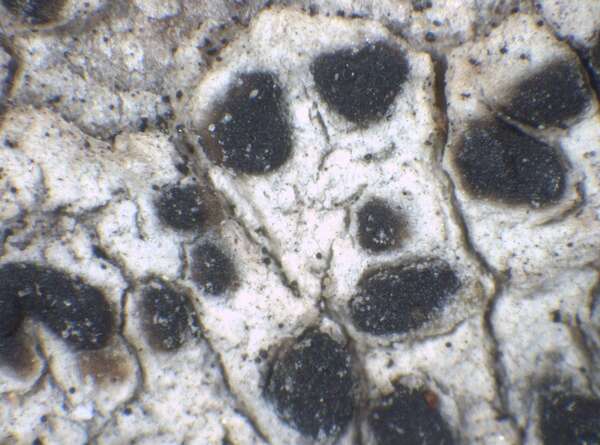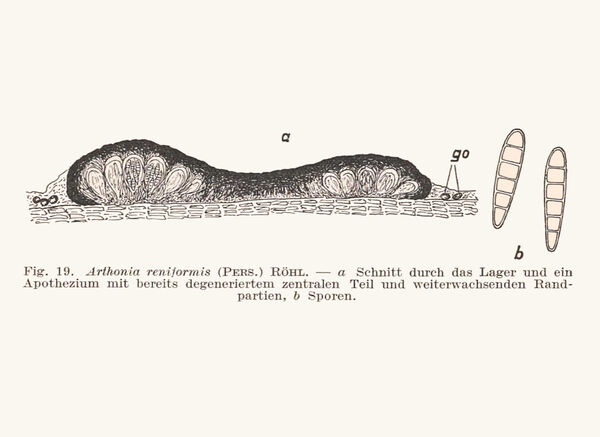Arthonia reniformis (Pers.) Nyl.
Flora, 59: 330, 1867. Basionym: Opegrapha reniformis Pers. - Ann. Bot. (Usteri), 7: 31, tab. II, fig. C, 1794.
Synonyms: Arthonia gyrosa Ach.; Arthonia obscura Ach.; Arthonia reniformis (Pers.) Röhl.; Arthonia vulgaris var. obscura (Ach.) Schaer.; Naevia gyrosa (Ach.) A. Massal.
Distribution: N - Ven, TAA. C - Sar (TSB 31118). S - Camp (CLU 10462), Cal (Puntillo 1996), Si (TSB 17252).
Description: Thallus crustose, episubstratic, thin, mostly continuous, strongly rugose, somewhat shiny, whitish to greenish grey, sometimes delimited by a dark prothalline line. Apothecia arthonioid, emarginate, black, round to irregularly lobed, 0.3-1(-1.5) mm across, 0.8-0.12 mm tall, often crowded and confluent, with a flat to slightly convex, epruinose disc, the central parts often degrading. Proper exciple poorly developed, reddish brown, of paraphysoid-like hyphae, 8-15 μm wide; epithecium brown-black, 10-25 µm high; hymenium colourless to pale reddish brown, 25-50 µm high, I+ reddish orange, K/I+ blue; paraphysoids coherent, richly branched, orientated in all directions, 1-1.5 μm thick at mid-level, the apical cells without a dark cap; hypothecium colourless to pale yellowish brown. Asci 8-spored, broadly clavate, semi-fissitunicate, with a large apical dome and a distinct ocular chamber, the tholus without horizontal layers, Arthonia-type. Ascospores 5-6-septate, hyaline but turning brownish when overmature, narrowly ellipsoid, pointed at one end, (12-)13-18(-20) x 4-6(-7) µm, the wall persistently smooth, surrounded by a thin gelatinous sheath. Pycnidia black, semi-immersed in the thallus. Conidia bacilliform, curved, (2-)3-4 x c. 1 µm. Photobiont trentepohlioid. Spot tests: thallus K- or K+ yellowish brown, C-, KC-, P-, UV-. Chemistry: without lichen substances. Note: a mild-temperate species of smooth bark, especially of Carpinus, more rarely of Fagus and Corylus, in humid deciduous woodlands. It is included in the Italian red list of epiphytic lichens as “Vulnerable” (Nascimbene & al. 2013c).
Growth form: Crustose
Substrata: bark
Photobiont: Trentepohlia
Reproductive strategy: mainly sexual
Commonnes-rarity: (info)
Alpine belt: absent
Subalpine belt: absent
Oromediterranean belt: absent
Montane belt: extremely rare
Submediterranean belt: extremely rare
Padanian area: absent
Humid submediterranean belt: very rare
Humid mediterranean belt: very rare
Dry mediterranean belt: absent

Predictive model
Herbarium samples
Growth form: Crustose
Substrata: bark
Photobiont: Trentepohlia
Reproductive strategy: mainly sexual
Commonnes-rarity: (info)
Alpine belt: absent
Subalpine belt: absent
Oromediterranean belt: absent
Montane belt: extremely rare
Submediterranean belt: extremely rare
Padanian area: absent
Humid submediterranean belt: very rare
Humid mediterranean belt: very rare
Dry mediterranean belt: absent

Predictive model
| Herbarium samples |
 INDEX FUNGORUM
INDEX FUNGORUM
 GBIF
GBIF
 DOLICHENS
DOLICHENS




